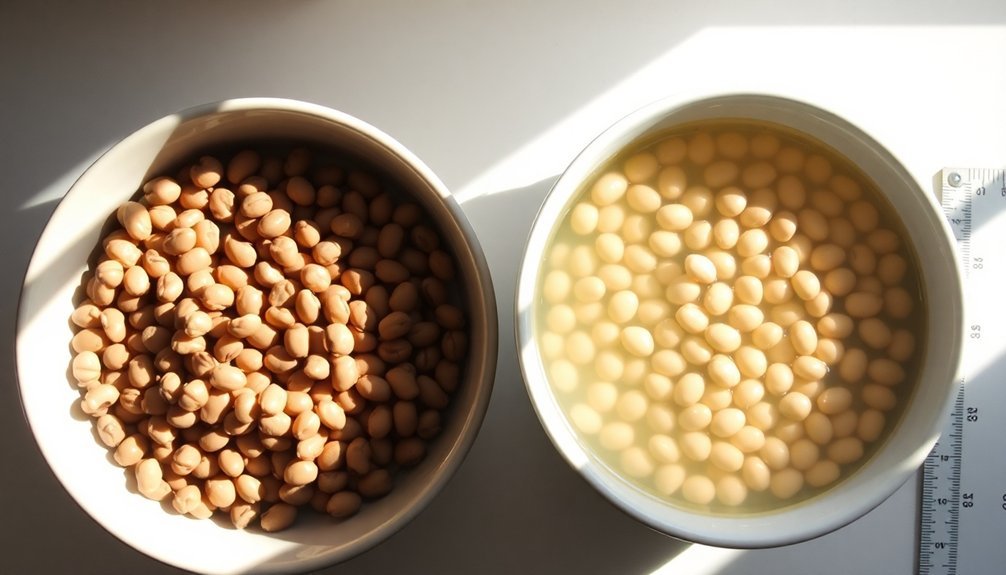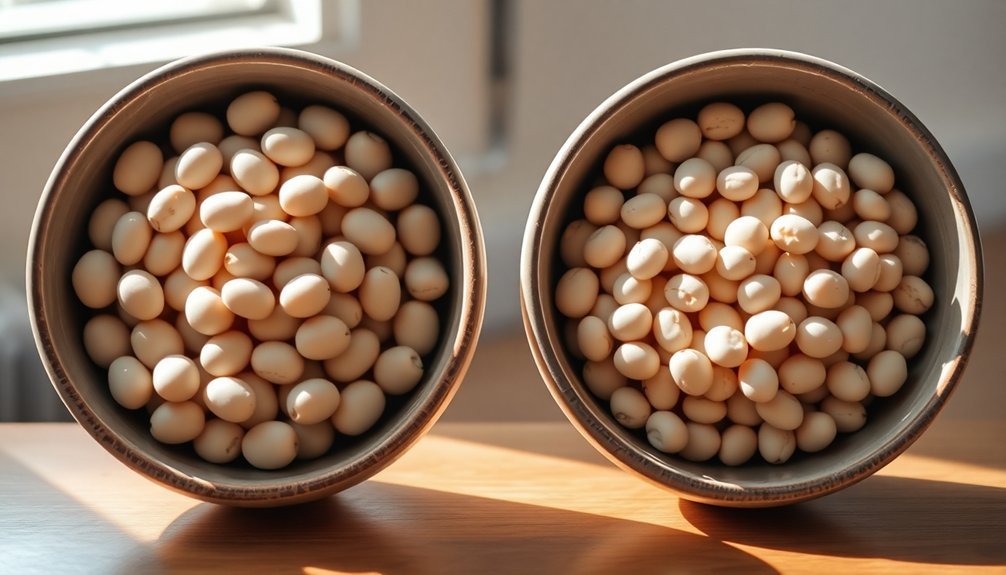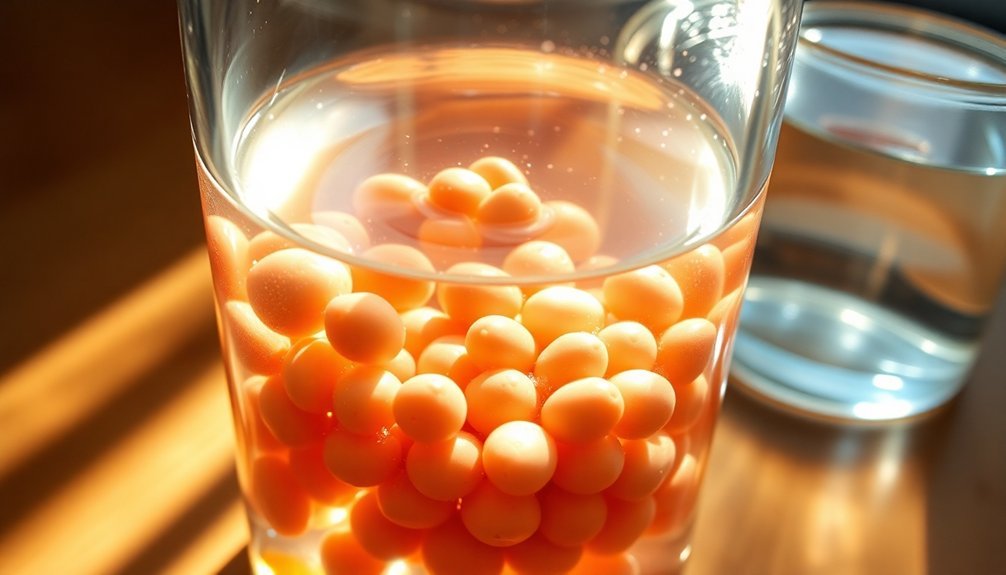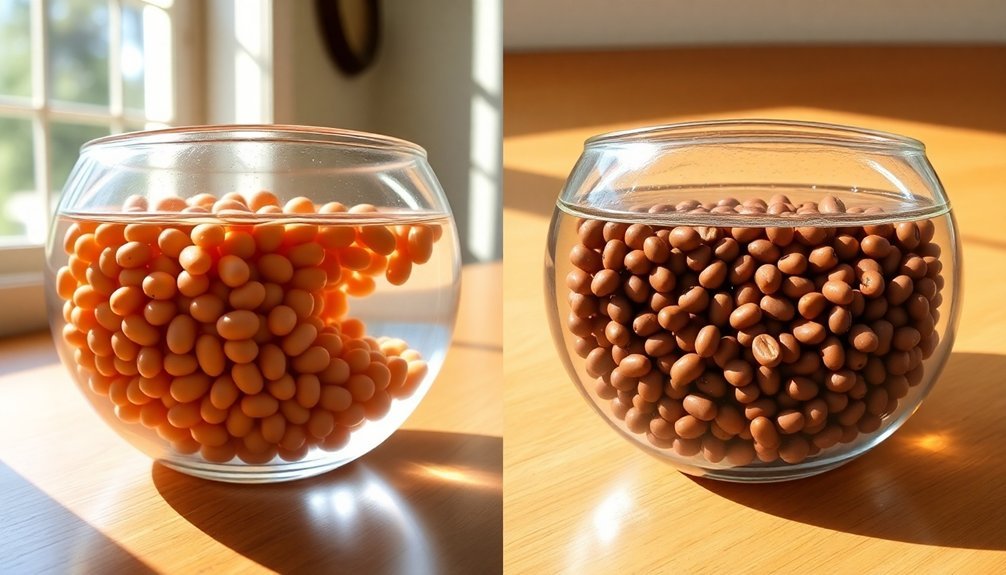Pre-soaking your beans before solar cooking delivers multiple crucial benefits. You'll slash cooking time by 75%, making the sun-heating process much more efficient. The soaking breaks down hard-to-digest compounds, reducing gas and bloating while improving your body's absorption of essential nutrients like iron, zinc, and calcium. By soaking overnight in a 3:1 water-to-bean ratio, you'll achieve evenly cooked, tender beans with better texture and enhanced flavor. Your beans will also maintain their shape better during the solar cooking process. These preparation steps release the full potential of your sun-heated bean dishes.
Benefits of Bean Soaking Methods

While many people skip the soaking step when preparing beans, this essential process offers significant benefits for both nutrition and digestion.
When you soak beans, you're breaking down oligosaccharides that can cause gas and bloating, making them easier on your digestive system.
Pre-soaking reduces antinutrients like phytic acid, tannins, and lectins that interfere with your body's ability to absorb essential minerals. You'll get more nutrition from your beans because soaking increases the bioavailability of iron, zinc, and calcium.
This process activates enzymes that break down phytic acid and other compounds that can block nutrient absorption. Using ten cups of water per pound of dry beans ensures optimal soaking results.
Additionally, you'll notice improved texture in your cooked beans. Soaking softens the beans, resulting in more evenly cooked, tender results and a creamier consistency in your finished dishes.
Time and Energy Conservation
Because pre-soaked beans require considerably less cooking time, you'll save both energy and effort in your meal preparation.
You'll notice dramatic reductions in cooking duration – for instance, cannellini beans cook in just 10 minutes when soaked, compared to 50 minutes unsoaked. Traditional methods recommend adding salt while soaking to enhance the beans' overall flavor.
When you're using sun-heating methods, pre-soaking becomes even more essential since you're working with limited sunlight hours.
Here's why soaking makes such a difference:
- You'll cut cooking time by up to 75% for most bean varieties
- You'll use markedly less fuel or solar energy to achieve fully cooked beans
- Your beans will cook more evenly, even with intermittent heat sources
- You'll streamline your kitchen workflow, especially when preparing large quantities
This efficiency particularly matters when you're relying on natural heat sources or cooking with limited resources.
Optimal Bean Texture

Beyond saving time and energy, pre-soaking beans dramatically improves their texture when sun-heating. You'll notice your beans cook more evenly, with both the skin and interior reaching the perfect tenderness simultaneously.
When you pre-soak, you're breaking down indigestible carbohydrates that can make beans tough and fibrous. If you choose to cook your beans in the same water you've soaked them in, you'll retain more nutrients while achieving a consistent texture throughout. Just like Jade II bush beans, this method helps beans adapt well to high temperatures during cooking.
The soaking process helps dissolve oligosaccharides, making your beans less stringy and more palatable. You can expect properly soaked beans to maintain their shape while becoming tender and crisp, rather than ending up with some parts overcooked and others undercooked.
This uniform cooking guarantees every bite is just right.
Digestive Health Advantages
You'll experience markedly less gas and bloating when you pre-soak your beans, as this process removes up to 90% of the oligosaccharides that cause digestive issues.
By soaking and draining the beans, you're improving your body's ability to absorb essential nutrients like iron, zinc, and calcium that are typically blocked by phytic acid.
Your stomach will break down the pre-soaked beans more efficiently, leading to smoother digestion and better nutrient utilization.
Reduced Gas and Bloating
A common complaint about beans – excessive gas and bloating – can be effectively managed through proper pre-soaking techniques.
When you don't soak your beans, oligosaccharides remain intact and get broken down by bacteria in your large intestine, producing uncomfortable gas and bloating.
To maximize digestive comfort when preparing beans for sun-heating:
- Soak your beans for 4-12 hours, preferably overnight, to reduce gas-causing compounds.
- Use the hot soaking method by initially boiling the water for better results.
- Discard the soaking water to remove released anti-nutrients like phytates and saponins.
- Rinse thoroughly before continuing with your sun-heating process.
You'll notice improved digestibility, reduced abdominal discomfort, and better overall gut health when you properly pre-soak your beans.
Better Nutrient Absorption Rates
Pre-soaking beans greatly improves your body's ability to absorb essential nutrients during digestion. When you soak beans, you'll neutralize phytic acid and other anti-nutrients that typically block mineral absorption. This process makes crucial minerals like magnesium, zinc, and iron more available for your body to use.
You'll get the best results by soaking overnight at room temperature or for three hours at 140º Fahrenheit. The soaking process activates natural enzymes that break down complex carbohydrates and proteins into simpler, more digestible forms.
To maximize nutrient retention, cook your beans in the same water you used for soaking. This preserves beneficial nutrients like calcium, thiamine, riboflavin, and niacin that may leach into the soaking liquid, ensuring you don't lose these valuable nutrients during preparation.
Easier Stomach Breakdown
Because soaking beans initiates the breakdown of complex compounds, your digestive system won't have to work as hard to process them.
When you pre-soak your beans, you're effectively starting the digestive process before the beans even enter your body, making them gentler on your stomach.
Your digestive comfort improves in these key ways:
- You'll experience less gas and bloating since soaking removes 75-90% of oligosaccharides, those troublesome indigestible sugars.
- You'll absorb more nutrients because the process eliminates enzyme inhibitors that can block proper digestion.
- You'll find the beans easier to break down due to their softened texture after soaking.
- You'll reduce your risk of digestive discomfort since soaking removes potentially irritating contaminants and field dust.
Solar Cooking Preparation Steps

To get the most from your solar cooking process, you'll want to soak your beans overnight in cold water using a 3:1 water-to-bean ratio.
When cooking at higher altitudes, increase your cooking time by roughly 10% for every 1,000 feet above sea level.
Choose a dark-colored pot for your solar cooking, as it absorbs heat more effectively and helps maintain consistent cooking temperatures.
Overnight Cold Water Method
When preparing beans for solar cooking, the overnight cold water method serves as an essential first step that greatly reduces cooking time and improves digestibility.
You'll need to follow a specific process to guarantee your beans are properly soaked and ready for solar cooking.
- Start by thoroughly inspecting and cleaning your dried beans using a colander, removing any damaged ones or debris.
- Place your cleaned beans in a large container, using the ratio of 6 cups of cold water for every 2 cups of beans to accommodate expansion.
- Store the container in a cool, dark place for at least 8 hours, making sure the beans stay completely submerged.
- After soaking, drain the water, rinse the beans with fresh cool water, and transfer them to a dark pot with enough fresh water to cover them by 1-2 inches.
Altitude Cooking Time Adjustments
Since altitude greatly affects solar cooking times, understanding the proper adjustments will guarantee your beans cook thoroughly.
At higher elevations, you'll need to increase both cooking duration and liquid content. For every 1,000 feet you climb, add 5% more cooking time to compensate for lower boiling temperatures.
To maintain proper moisture, you'll need to adjust your liquid ratios based on your elevation: add 10% more liquid at 2,000-4,000 feet, 15% at 4,000-6,000 feet, and 20% at 6,000-8,000 feet.
Position your solar cooker between 10 AM and 3 PM for ideal results, and reposition it frequently to track the sun.
Choose dense, high-quality beans that can withstand extended cooking times, as they'll perform better under these conditions.
Remember that your cooking time might extend to 2-3 hours or longer.
Dark Pot Selection Tips
Selecting the right pot plays an essential role in successful solar cooking. You'll want to focus on dark-colored containers that effectively absorb and retain heat while cooking your pre-soaked beans. Enamel and cast iron pots work well, though the latter takes longer to heat initially.
- Choose pots with well-fitting lids to trap heat and maintain consistent cooking temperatures.
- Opt for shallow rather than deep containers, as they heat more efficiently in solar conditions.
- Confirm your pot has a non-reflective surface – if needed, apply non-toxic flat black paint to the exterior.
- Add a clear heat trap, such as an oven bag or inverted glass bowl, around your pot to create a greenhouse effect.
When painting your pot, remember to only coat the exterior, keeping the interior surface unmodified for food safety.
Nutrient Enhancement Through Soaking
Although soaking beans may seem like a simple preparation step, this process greatly enhances their nutritional value. When you soak your beans, you'll break down phytic acid, which typically binds to essential minerals like iron, calcium, and manganese. This breakdown makes these nutrients more available for your body to absorb.
You'll also reduce antinutrients such as lectins, tannins, and saponins through soaking, which improves both nutrient absorption and digestibility. The process can remove up to 15.4% more phytic acid compared to unsoaked beans.
Additionally, you'll break down complex sugars called oligosaccharides, reducing the likelihood of digestive discomfort like gas and bloating. For ideal nutrition, consider soaking your beans overnight before sun-heating, as this helps retain more protein, fiber, and minerals than canned alternatives.
Common Bean Soaking Mistakes

Four common mistakes can derail your bean soaking success before sun-heating. Understanding these pitfalls will help you achieve perfectly tender, digestible beans that are ready for the sun-heating process.
1. Using hard or chlorinated water prevents beans from softening properly due to calcium and magnesium interference.
You'll want to use soft water or boil your tap water for 15 minutes first.
2. Not changing the soaking water leads to increased gas production.
Replace the water before cooking to reduce oligosaccharides that cause flatulence.
3. Following incorrect soaking methods, like cold soaking, may result in unevenly cooked beans.
A hot soak for 4-6 hours typically works better than the traditional 8-hour cold soak.
4. Over-salting the soaking water can make your beans too salty.
While brining helps with texture, moderation is key.
Frequently Asked Questions
Can Soaked Beans Be Frozen for Later Use in Solar Cooking?
Yes, you can freeze soaked beans for up to 6 months. Just drain and rinse them, store in sealed freezer bags, and thaw them before solar cooking. They'll maintain their texture and nutritional benefits.
What Happens if You Accidentally Over-Soak Beans Beyond 24 Hours?
If you've over-soaked beans past 24 hours, they'll become mushy and lose flavor. You'll notice decreased texture quality, nutrient loss, and possibly fermentation. It's best to drain and cook them immediately.
Does Altitude Affect the Soaking Time for Beans?
Yes, altitude affects your bean soaking time. You'll notice slower water uptake at higher elevations, so you'll need to extend soaking periods. The cooler temperatures at high altitudes also slow down the hydration process.
Can Hot Water Be Used Instead of Cold Water for Soaking?
Yes, you can use hot water for soaking beans. It's actually more efficient than cold water, cutting your soaking time to 1-4 hours and doing a better job dissolving gas-causing sugars.
Should Different Types of Beans Be Soaked Separately or Together?
You'll want to soak different types of beans separately since they have varying absorption rates and cooking times. This guarantees each variety achieves its ideal texture and prevents some beans from becoming mushy while others remain hard.
In Summary
Pre-soaking your beans before solar cooking isn't just about saving time – it's vital for better results. You'll cut down on cooking hours, guarantee even heating, and make your beans more digestible by reducing anti-nutrients. Remember to soak them overnight in cool water, and you'll get tender, evenly cooked beans while making the most of solar energy. Don't skip this vital step in your sun-cooking process.





Leave a Reply